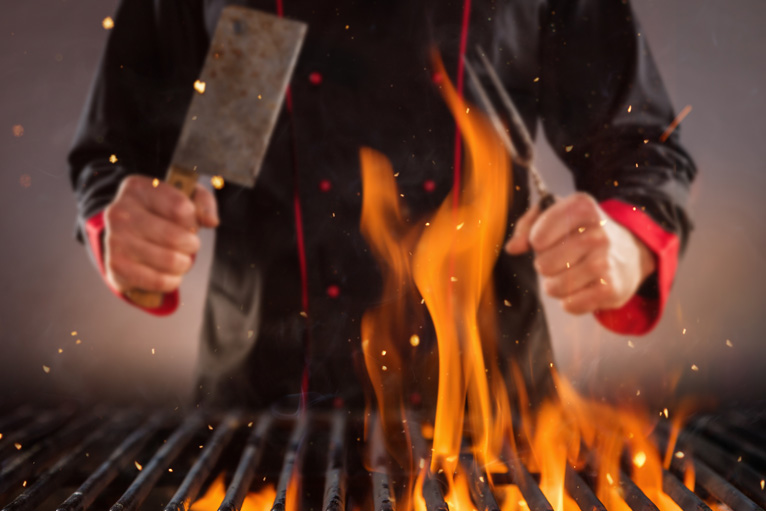Why are they different than non-solid fuel cooking operations and what are best practices when used with a Pollution Control System?
As the name implies, Solid Fuel cooking operations are any cooking equipment that utilizes solid fuel for cooking the food product as opposed to using solid fuel for flavoring. Gas-operated equipment that uses solid fuel for flavoring must meet various conditions outlined in NFPA 96, Chapter 14.3.4. These types of appliances do not require separate exhaust. This article will address solid fuel appliances that use wood, charcoal, and alike as the heating source for cooking.
NFPA 96, Chapter 14 details the requirements for solid fuel applications and the venting required. A significant difference with solid fuel appliances is that they must have their own exhaust hood and duct system. They can not be combined with a non-solid fuel hood with a mixed line (gas and electric appliances).
Much care must be taken to ensure that the potential fire hazard is mitigated and that maintenance and upkeep of the system are strictly adhered to. The exhaust hood must be rated (UL710) for solid fuel applications. These hoods have certain features that help mitigate the potential for embers carrying into the ductwork. Make no mistake, even with a solid fuel listing; embers can carry be carried into the ductwork.
A recommended hood type for use with solid fuel is a continuous mist hood. This type of hood sprays a fine water mist inside the exhaust plenum. This type of hood accomplishes a couple of things.
- The exhaust air temperature is decreased
- The sparks and embers are decreased when they travel through the extraction filters and water spray
To ensure they do not get coated with creosote or cast off from the burning process, great care should be taken to inspect the water nozzles periodically. Follow the manufacturer’s instructions on care and maintenance to the letter.
A listed fire extinguishing system for solid fuel is required and must be of sufficient size and capacity to totally extinguish the entire hazard area. Further details can be found in NFPA 96 Chapter 14.7
The exhaust fan must be listed per UL 705, Supplement SC – Power Roof Ventilators for Restaurant Exhaust Appliances.
When utilizing a Pollution Control Unit on a solid fuel application, close attention must be paid to the type of grease extraction being used. There are two main types, media filter units that require changing the filters when loaded and Electrostatic Precipitators, which use a wash-in-place manifold on the collecting cells to remove airborne effluent.
Since the loading on a solid fuel application is significant, a double-pass ESP is recommended. These systems come equipped with high-temperature safety filters before the odor module and HEPA type filters if smoke removal is paramount.
Newer systems are now being designed with additional safety features that would help mitigate a fire in the unit. While no system can guarantee that a fire will not ignite in a unit, much can be done to reduce the chance of that occurring.
Look for a system with multiple RTD temperature sensors (Resistive Temperature Detector) on the inlet of the collecting cells and after the high-temperature media filters. This will measure an increase in temperature from the inlet of the cells to the outlet, which is a strong indicator of fire initiating. The system would activate the wash system and spray water through the cells that would carry through to the odor module. The ESP cells would be deactivated, and the exhaust fan would continue to run. The system would not interfere with the operation of the fire suppression system installed in the Pollution Control System. More sophisticated systems will even alarm in the kitchen by sounding an audible alarm combined with flashing lights in the hood.
The purpose of these systems is to limit the potential for injury of personnel or loss of property.
Solid Fuel applications have their challenges, but with the proper planning and a rigorous maintenance program in place, they can operate without incident.
Should you require help in selecting a solution for a solid fuel cooking application, the experts that manufacture these types of units can guide you on the proper selection needed to meet your requirements.

Read another article relating to Pollution Control Units – New Regulations for Pollution Control Units for Commercial Cooking
Subscribe to kitchenventilation.com
Stay up to date by subscribing to Halton’s Commercial Kitchen Ventilation Blogs by entering your email address to subscribe and Halton will provide you with the latest information on commercial kitchen exhaust hoods, pollution control units, air handling, and safety systems. You will receive notifications of new posts by email.

